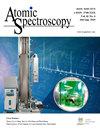Continuous Online Leaching System Coupled With Inductively Coupled Plasma Mass Spectrometry For Assessment Of Cr, As, Cd, Sb, And Pb In Soils
IF 2.3
2区 化学
Q1 SPECTROSCOPY
引用次数: 3
Abstract
Incidental ingestion of soil containing Cr, As, Cd, Sb, and Pb has been attracting global attention as it can significantly impact human health. Many bioaccessibility methods have been developed to simulate the amount of contaminants extracted by gastrointestinal fluids following incidental ingestion. Although the continuous online leaching method (COLM) offers various advantages over conventional batch bioaccessibility methods, such as reduced analysis time, elemental source apportionment, and isotopic analysis, it has not yet been applied to soil and directly compared to validated, published methods. This study uses the COLM with simulated gastrointestinal fluids from the United States Environmental Protection Agency (US EPA), United States Pharmacopeia (USP), and unified bioaccessibility method (UBM) to measure the bioaccessibility of Cr, As, Cd, Sb, and Pb in NIST 2710, NIST 2710a, NIST 2711a, and BGS 102. When the US EPA gastrointestinal fluid was used, no significant difference was observed between the COLM bioaccessible + residual, aqua regia extraction, or certificate concentrations for all the elements and soils studied. Furthermore, COLM bioaccessibility was within the acceptable range of control limits and bioavailability (animal) studies for most reference materials. In addition, no statistically significant difference was observed between either the US EPA batch method or the stomach phase of the UBM batch method and the stomach stage of the COLM, indicating that the COLM could be incorporated into current bioaccessibility analyses to improve soil contamination characterization in the future.连续在线浸出系统耦合电感耦合等离子体质谱法评估土壤中Cr、As、Cd、Sb和Pb
偶然摄入含Cr、As、Cd、Sb和Pb的土壤已引起全球关注,因为它会对人体健康产生重大影响。已经开发了许多生物可及性方法来模拟偶然摄入后由胃肠道液体提取的污染物的量。尽管连续在线浸出法(COLM)与传统的批量生物可及性方法相比具有多种优势,如减少分析时间、元素源分配和同位素分析,但它尚未应用于土壤,也未与已发表的验证方法直接进行比较。本研究采用COLM和美国环境保护署(US EPA)、美国药典(USP)的模拟胃肠液,以及统一生物可及性法(UBM)测量了NIST 2710、NIST 2710a、NIST 2711a和BGS 102中Cr、As、Cd、Sb和Pb的生物可及性。当使用US EPA胃肠道液时,所研究的所有元素和土壤的COLM生物可及+残留物、王水萃取物或证书浓度之间没有显著差异。此外,COLM的生物可及性在大多数标准物质的控制限度和生物利用度(动物)研究的可接受范围内。此外,美国EPA批处理法或UBM批处理法的胃期与COLM的胃期之间没有统计学差异,这表明COLM可以纳入当前的生物可达性分析,以改善未来土壤污染表征。
本文章由计算机程序翻译,如有差异,请以英文原文为准。
求助全文
约1分钟内获得全文
求助全文
来源期刊

Atomic Spectroscopy
物理-光谱学
CiteScore
5.30
自引率
14.70%
发文量
42
审稿时长
4.5 months
期刊介绍:
The ATOMIC SPECTROSCOPY is a peer-reviewed international journal started in 1962 by Dr. Walter Slavin and now is published by Atomic Spectroscopy Press Limited (ASPL). It is intended for the rapid publication of both original articles and review articles in the fields of AAS, AFS, ICP-OES, ICP-MS, GD-MS, TIMS, SIMS, AMS, LIBS, XRF and related techniques. Manuscripts dealing with (i) instrumentation & fundamentals, (ii) methodology development & applications, and (iii) standard reference materials (SRMs) development can be submitted for publication.
 求助内容:
求助内容: 应助结果提醒方式:
应助结果提醒方式:


